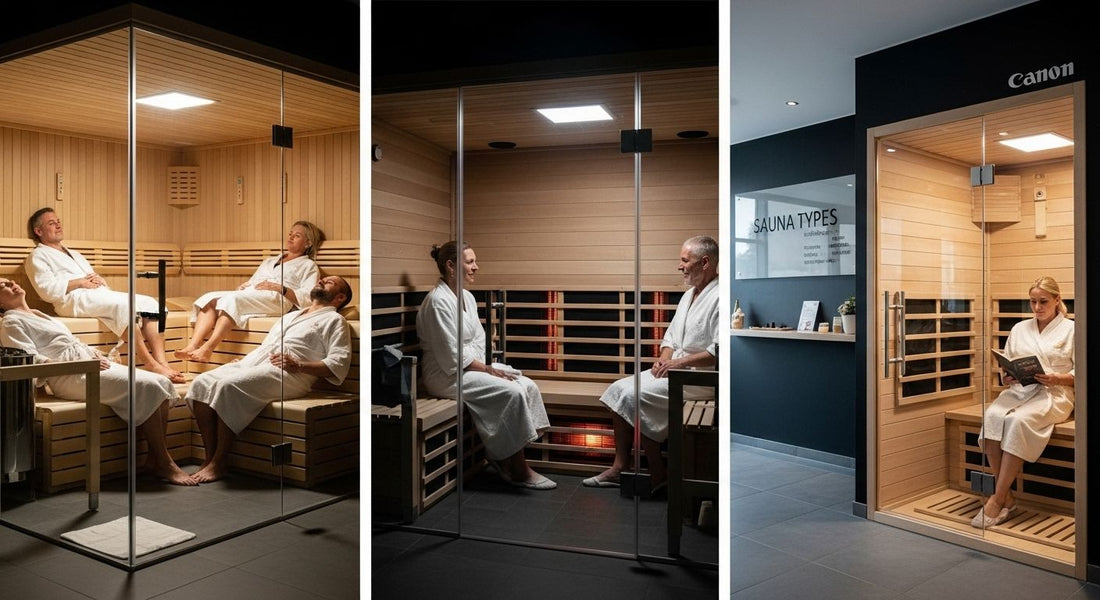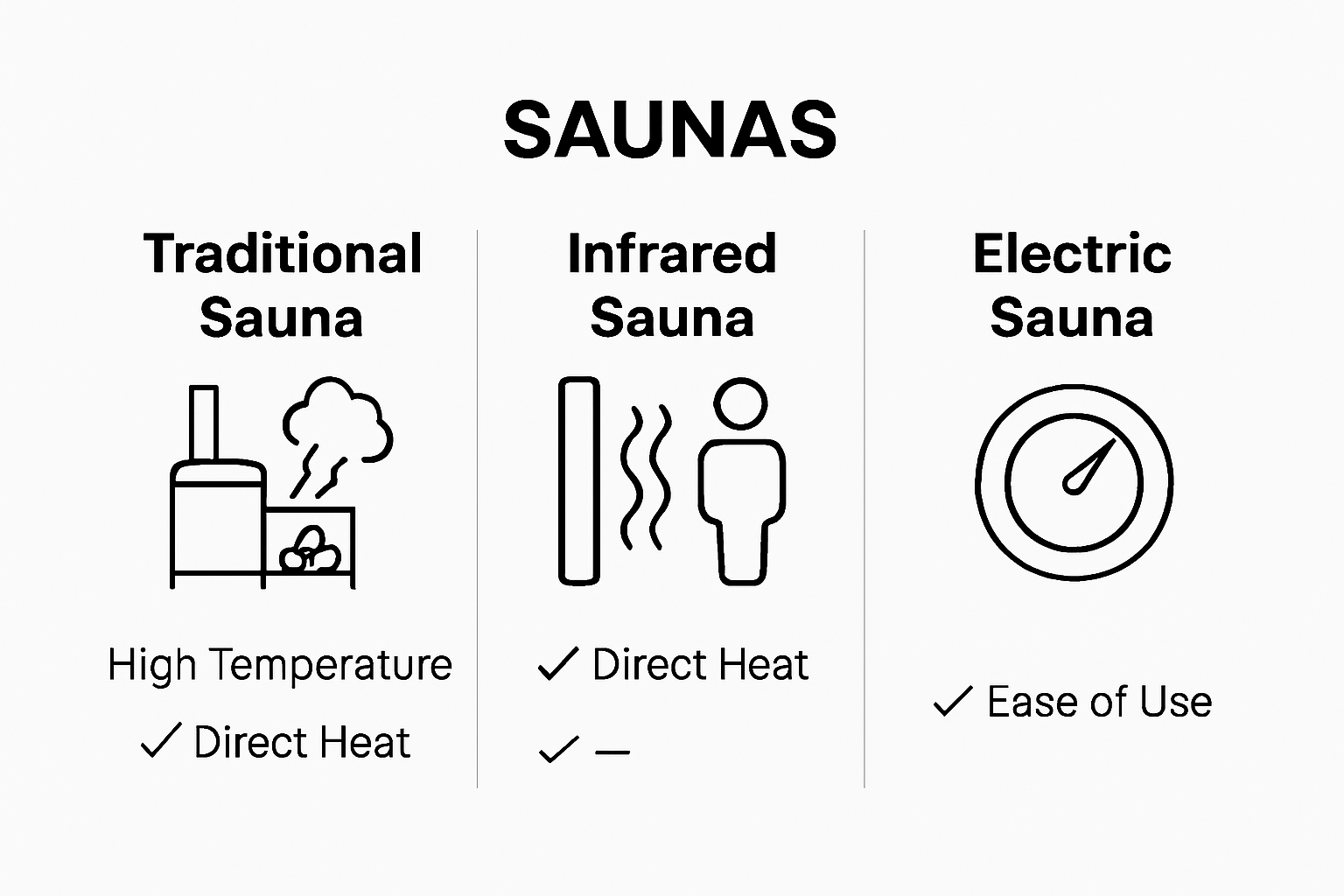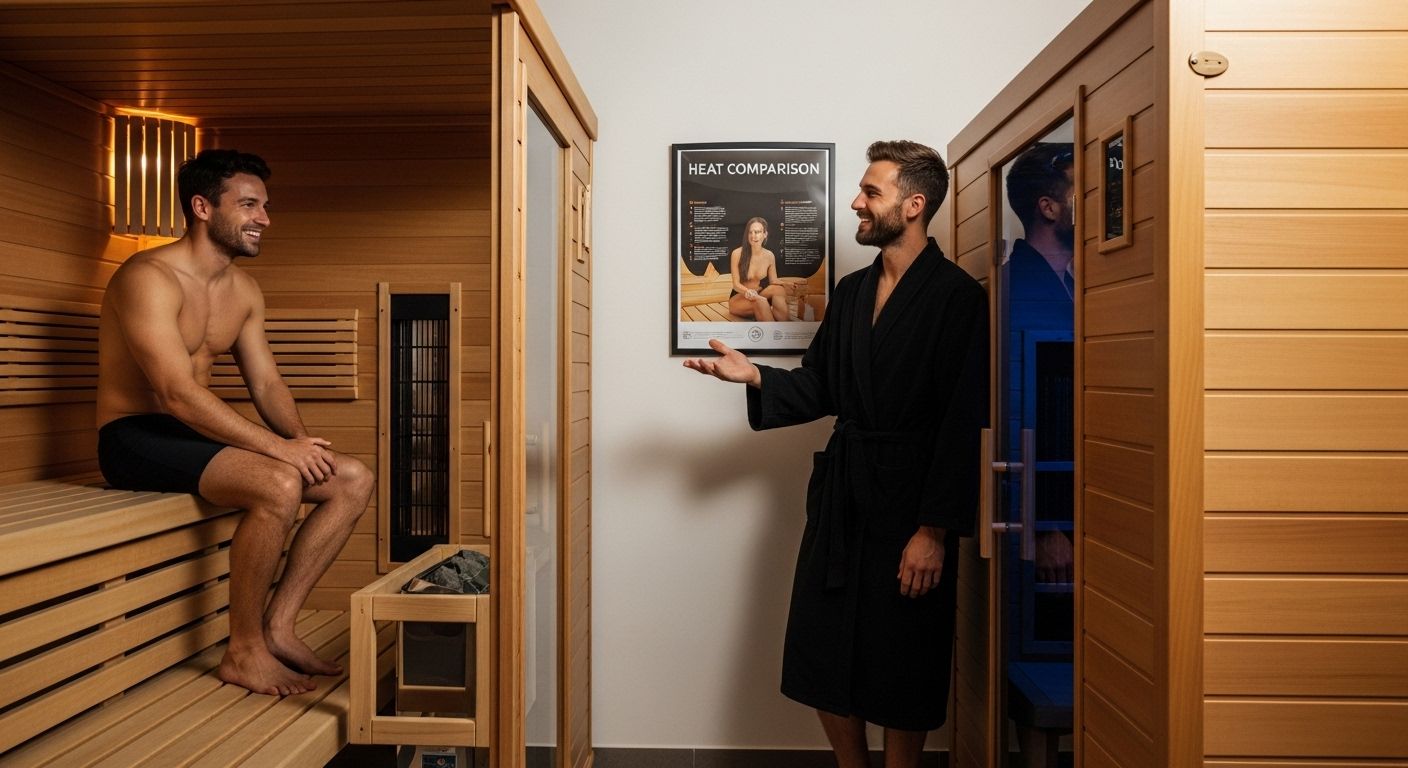
Understanding Comparisons of Sauna Types for Better Relaxation

Saunas are no longer just a Nordic tradition. Today, they come in futuristic designs that fit right in your home, with benefits that go far beyond simple relaxation. While most people picture a wooden room packed with steam, modern infrared saunas use light waves to gently heat your body at just 40 to 60 degrees Celsius, over 30 degrees cooler than classic styles. What surprises many is that these lower temperatures can create a deeper, more targeted physiological effect without the sweltering heat.
Table of Contents
- What Are The Main Types Of Saunas?
- Why Sauna Choice Matters For Your Health And Wellness
- How Different Sauna Types Generate Heat
- Key Features And Benefits Of Each Sauna Type
- Real-World Applications And Popularity Of Sauna Types
Quick Summary
| Takeaway | Explanation |
|---|---|
| Choose sauna based on health goals | Different saunas provide unique benefits, influencing cardiovascular health and relaxation. Select based on personal needs. |
| Traditional saunas offer high heat exposure | Finnish saunas at 70-100°C promote intense cardiovascular responses and deep relaxation through high humidity. |
| Infrared saunas penetrate tissues deeply | Operating at 40-60°C, they target muscles and joints directly, potentially easing pain and aiding recovery. |
| Portable saunas provide convenience | Ideal for small spaces or those seeking a user-friendly option. Electric models heat quickly and offer precise control. |
| Evaluate personal temperature tolerance | Understand your comfort level and any health conditions that might affect sauna use to ensure a beneficial experience. |
What Are the Main Types of Saunas?
Understanding comparisons of sauna types requires exploring the unique characteristics and heating methods that define different sauna experiences. Saunas have evolved significantly, offering diverse options for relaxation, health benefits, and personal wellness.
Traditional Finnish Saunas
Traditional Finnish saunas represent the original sauna experience, characterized by high temperatures and low humidity. According to Mayo Clinic Proceedings, these saunas typically operate between 70 to 100 degrees Celsius, using wood or electric heaters with stones that generate intense heat and steam when water is poured over them.
Key features of traditional Finnish saunas include:
- Authentic wood-burning or electric heating systems
- High temperature environments
- Ability to create steam by pouring water on heated stones
- Deep cultural roots in Nordic wellness practices
Infrared Saunas
Infrared saunas represent a modern approach to heat therapy, utilizing light waves to directly warm the body instead of heating the surrounding air. Mayo Clinic explains that these saunas operate at lower temperatures around 40 to 60 degrees Celsius, providing a gentler heating experience.
Unlike traditional saunas, infrared saunas penetrate body tissues more deeply, potentially offering unique therapeutic benefits. The radiant heat targets muscles and joints directly, creating a different physiological response compared to conventional sauna types.
Portable and Electric Saunas
With technological advancements, portable and electric saunas have emerged as convenient alternatives for home wellness enthusiasts. These compact units provide flexibility for individuals with limited space or those seeking more accessible sauna experiences.
Electric saunas offer precise temperature control and quick heating mechanisms, making them user friendly and adaptable to various home environments. They eliminate the need for wood preparation while maintaining the core sauna experience of heat therapy and relaxation.
Why Sauna Choice Matters for Your Health and Wellness
Selecting the right sauna is more than a matter of personal preference it is a strategic decision that can significantly impact your overall health and wellness journey. Different sauna types offer unique physiological responses and potential health benefits, making informed selection crucial for maximizing therapeutic potential.
Cardiovascular Health Considerations
Sauna selection directly influences cardiovascular performance and potential health outcomes. According to Mayo Clinic Proceedings, regular sauna bathing is associated with reduced risk of vascular diseases, including high blood pressure and cardiovascular complications.
Key cardiovascular benefits vary across sauna types:
- Traditional saunas provide intense heat exposure
- Infrared saunas offer deeper tissue penetration
- Heat therapy can potentially improve blood circulation
- Different temperature ranges impact cardiovascular response
Thermal Stress and Physiological Adaptation
The choice between sauna types determines the body’s thermal stress response and adaptation mechanisms. Heat exposure triggers multiple physiological reactions, including increased heart rate, enhanced sweating, and potential metabolic improvements.
Infrared saunas operate at lower temperatures but provide more direct tissue heating, creating a gentler yet potentially more targeted therapeutic experience. Traditional Finnish saunas, with higher temperatures, induce more intense physiological stress responses that can stimulate stronger cardiovascular and thermoregulatory adaptations.
Personalized Wellness Strategies
Individual health goals, medical history, and personal comfort levels should guide sauna selection. Factors such as temperature tolerance, existing health conditions, and specific wellness objectives play crucial roles in determining the most appropriate sauna type.
Considerations for personalized sauna selection include:
- Current fitness and health status
- Specific therapeutic goals
- Temperature and humidity preferences
- Potential underlying medical conditions
By understanding the nuanced differences between sauna types, individuals can make informed decisions that align with their unique wellness journeys and optimize potential health benefits.
To help you quickly compare the distinguishing features, heating methods, and benefits of sauna types, the following table summarizes key aspects of Traditional Finnish, Infrared, and Portable/Electric saunas.
| Sauna Type | Heating Method | Typical Temperature Range | Key Benefits | User Considerations |
|---|---|---|---|---|
| Traditional Finnish | Wood or electric heater with stones | 70–100°C (158–212°F) | Intense cardiovascular response, deep relaxation, cultural tradition | Tolerates higher heat, requires more space, usually permanent installation |
| Infrared | Light waves/panels (infrared) | 40–60°C (104–140°F) | Deep tissue penetration, muscle/joint relief, gentler heat | Lower ambient heat, good for pain relief, can be portable |
| Portable/Electric | Electric coils/panels | Variable (usually 40–70°C) | Convenience, precise control, space-saving | Ideal for limited space, quick setup, may lack steam feature |
How Different Sauna Types Generate Heat
Heat generation represents the fundamental mechanism that distinguishes various sauna types, creating unique physiological experiences through distinct thermal transfer methods. Understanding these heating mechanisms reveals the intricate science behind sauna technology and its impact on human wellness.
Traditional Sauna Heating Principles
Traditional saunas utilize direct and radiant heat transfer methods that warm the surrounding environment and subsequently heat the human body. According to PubMed research, these saunas typically employ electrical or wood-burning stoves that generate high air temperatures between 80 to 100 degrees Celsius with low humidity levels.
Key characteristics of traditional sauna heating include:
- Radiation energy from stove surfaces
- High ambient air temperatures
- Convective and conductive heat transfer
- Ability to create steam by pouring water on heated stones
Infrared Heat Transmission
Infrared saunas represent a revolutionary approach to heat generation, using specialized panels that emit electromagnetic radiation directly absorbed by human tissue. Unlike traditional methods, infrared technology penetrates the body more efficiently, creating a more targeted heating experience at lower ambient temperatures.
The infrared heating mechanism operates through light wavelengths that interact directly with body molecules, generating internal warmth without extensively heating the surrounding air.
This approach allows for more precise and potentially more comfortable heat exposure, enabling deeper tissue penetration with less environmental heat stress.
Advanced Heating Technology Comparisons
Modern sauna technologies continue to evolve, introducing nuanced heating approaches that optimize user experience and potential health benefits. Electric saunas now incorporate precise temperature controls and rapid heating mechanisms, while hybrid models combine traditional and infrared technologies.
Critical considerations in heat generation technologies include:

- Energy efficiency
- Heating speed
- Temperature consistency
- Penetration depth of thermal energy
By understanding these diverse heat generation methods, individuals can select sauna experiences that align most closely with their wellness goals and physiological preferences.
Key Features and Benefits of Each Sauna Type
Understanding the unique characteristics of different sauna types allows individuals to select the most appropriate wellness experience for their specific health and relaxation goals. Each sauna variant offers distinct physiological interactions and potential therapeutic advantages.
Traditional Finnish Sauna Benefits
Traditional Finnish saunas provide an intense heat experience that has been cultivated through centuries of cultural wellness practices. According to Mayo Clinic Proceedings, regular sauna bathing is associated with significant cardiovascular health improvements and reduced risk of vascular diseases.
Key benefits of traditional saunas include:
- Enhanced cardiovascular performance
- Improved circulatory system function
- Potential reduction in blood pressure
- Stress relief and mental relaxation
- Natural detoxification through intense sweating
Infrared Sauna Unique Advantages
Infrared saunas represent a modern approach to heat therapy, offering more targeted and potentially gentler therapeutic experiences. These saunas generate heat through light wavelengths that directly penetrate body tissues, creating a different physiological response compared to traditional heating methods.
Specific advantages of infrared saunas include deeper tissue heating, lower ambient temperatures, and potentially more comfortable extended sessions. The precise light wavelength penetration allows for more focused muscle and joint treatment, making them particularly appealing for individuals seeking muscle recovery and pain management.
Specialized Sauna Experience Considerations
Beyond traditional and infrared options, emerging sauna technologies continue to expand wellness possibilities. Portable electric saunas and hybrid models provide flexible solutions for diverse user needs, enabling personalized heat therapy experiences.
Critical factors to consider when selecting a sauna type include:
- Personal health objectives
- Temperature tolerance
- Available space
- Budget constraints
- Specific therapeutic requirements
By carefully evaluating these nuanced differences, individuals can select a sauna experience that optimally supports their overall wellness journey and provides the most beneficial heat therapy approach.

Real-World Applications and Popularity of Sauna Types
Sauna technologies have transcended cultural boundaries, evolving from traditional Nordic practices to global wellness phenomena with diverse applications across health, fitness, and personal relaxation strategies. Understanding their real-world implementation reveals the profound impact of these thermal experiences.
Cultural and Wellness Adoption
Sauna usage represents more than just a therapeutic practice it is a multifaceted wellness approach with deep societal roots. According to global survey research, 83.5% of participants reported improved sleep quality after sauna sessions, highlighting the widespread recognition of its potential health benefits.
Key cultural adoption trends include:
- Integration into athletic recovery protocols
- Wellness center and spa programming
- Home wellness design trends
- Corporate health and employee wellness initiatives
- Holistic health and preventative care strategies
Professional and Athletic Applications
Athletes and fitness professionals have increasingly embraced sauna technologies as critical components of recovery and performance optimization. Traditional Finnish and infrared saunas offer distinct advantages for muscle recovery, inflammation reduction, and physiological stress management.
Professional applications span multiple domains:
- Sports medicine rehabilitation
- Elite athlete recovery protocols
- Physical therapy supplementation
- Performance enhancement strategies
- Stress reduction for high-performance professionals
Consumer Market Trends
The consumer market for sauna technologies demonstrates remarkable growth and diversification. Emerging trends indicate a shift towards more personalized, technologically advanced home wellness solutions that prioritize convenience and targeted health benefits.
Consumer preference factors include:
- Compact and portable design options
- Smart technology integration
- Energy efficiency
- Customizable heating experiences
- Aesthetic compatibility with home design
By understanding these real-world applications, individuals can appreciate saunas not just as luxury amenities but as sophisticated wellness technologies with comprehensive health potential.
Choose The Perfect Sauna Experience for Your Wellness Journey
Exploring sauna types can leave you feeling uncertain about which option best matches your unique wellness goals. After reading about the differences between traditional Finnish, infrared, and portable electric saunas, you might still wonder which solution will truly deliver the relaxation, health benefits, and comfort you desire. The article details how key features like heat generation, temperature tolerance, and personal health needs play a critical role in your sauna experience. The challenge is not just about information, but about finding a product that fits your lifestyle and transforms your daily routine.
Take control of your wellness by discovering a full range of premium sauna solutions designed to match your exact needs. Whether you are seeking intense heat, gentle infrared therapy, or a user-friendly portable option, our collection at Best Life Sauna gives you the freedom to select what will serve you best. Each product highlights health benefits like improved circulation and natural stress relief, proving you do not have to compromise between comfort and results.

Do not wait to put your wellness first. Explore our curated selection of saunas and wellness products and see why customers trust us for quality, value, and support. Visit Best Life Sauna today and take the first step toward lasting relaxation and health.
Frequently Asked Questions
What are the main differences between traditional Finnish saunas and infrared saunas?
Traditional Finnish saunas operate at high temperatures (70 to 100 degrees Celsius) with low humidity, using wood or electric heaters to create steam. In contrast, infrared saunas work at lower temperatures (40 to 60 degrees Celsius) and use light waves to directly heat the body, providing a gentler experience.
How do saunas benefit cardiovascular health?
Regular sauna bathing, especially in traditional saunas, is linked to improved cardiovascular performance and reduced risk of vascular diseases. The intense heat exposure in these saunas can improve blood circulation and may aid in lowering blood pressure.
Can I use a sauna if I have specific health conditions?
It’s essential to consider your individual health status, medical conditions, and comfort levels when selecting a sauna type. Certain conditions might warrant consultations with a healthcare provider to determine the safest and most beneficial sauna experience for you.
What are portable saunas, and how do they differ from traditional saunas?
Portable saunas are compact, easily assembled units designed for home use, offering flexibility and convenience. Unlike traditional saunas, portable options typically require less space and provide precise temperature control with electric heating, making them accessible for those with limited room for a permanent sauna.

